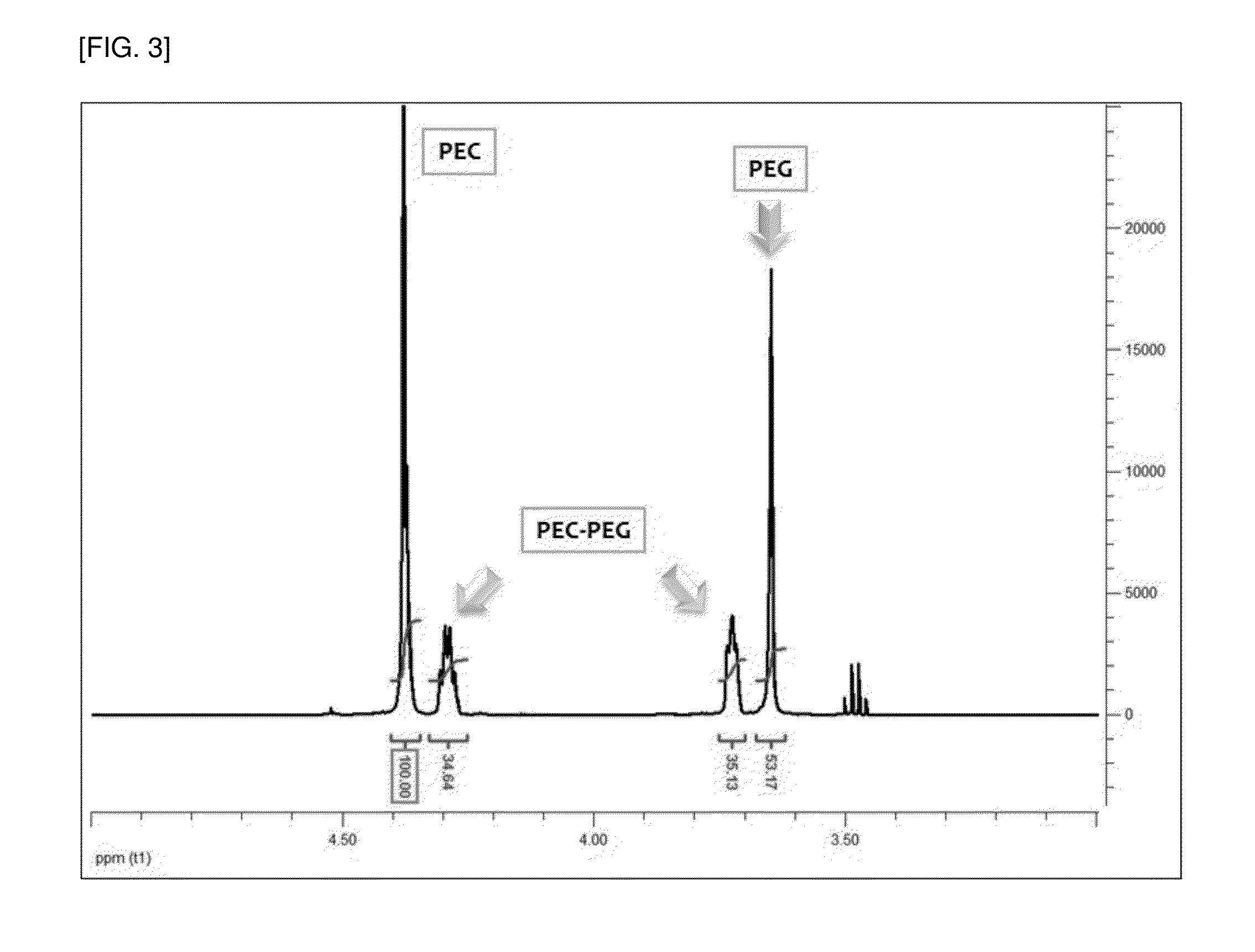Method for preparing polyalkylenecarbonate
a polyalkylene carbonate and polyalkylene technology, applied in the field of polyalkylene carbonate preparation, can solve the problems of long polymerization time, low polymerization activity, and high pdi, and achieve the effects of high selectivity, reduced danger due to local overheating of reactants, and high conversion rate of epoxide monomers
- Summary
- Abstract
- Description
- Claims
- Application Information
AI Technical Summary
Benefits of technology
Problems solved by technology
Method used
Image
Examples
experimental example 1
Experiment of Confirming Solvent According to Solution Polymerization 1
[0057]For process stability at scale up, a bulk polymerization was converted into a solution polymerization, and a solvent suitable for PEC polymerization using a ZnGA-AA catalyst was screened (designated as Experimental Examples 1a to 1f). Wherein, acetic acid was mixed in the amount of 1 part by weight per 100 parts by weight of ZnGA to prepare a ZnGA-AA catalyst.
[0058]Specifically, while moisture and oxygen were blocked, the ZnGA-AA catalyst and ethyleneoxide were introduced into a reactor. In addition, as a solvent, ethylene dichloride (EDC) was additionally introduced, and 20 or 25 bar of carbon dioxide gas was introduced into the reactor, and then, solution polymerization was conducted in a closed state. Wherein, the amount of the catalyst and each material used are as shown in the Table 1.
[0059]In addition, while maintaining reaction temperature at 80° C., reaction time was changed to 6 hours, 20 hours and...
experimental example 2
Experiment of Confirming Solvent According to Solution Polymerization 2
[0066]A copolymer of ethyleneoxide and carbon dioxide was prepared under the conditions of Table 2 by the same procedure as Example 1, except using methylenechloride (MC) as a solvent. The results of solution polymerization using a ZnGA-AA catalyst and MC are shown in Tables 2 and 3. Wherein, carbon dioxide introduced into the reactor was continuously supplied.
TABLE 22a2b2cEO:MC =EO:MC =EO:MC =1:0.561:1.051:0.94Cat. amt(g)0.10.1020.108EO(g)7.548.079.25solvent (MC)(g)4.258.518.70EO / cat.334351380CO2(bar)232222Temperature(° C.)808080Time(h)202020Yield(g)7.6807.8007.680Yield(g / g-cat)777671Activity(g / g-cat · hr)3.8403.8243.556Conversion(%)51%48%42%rate of EOTOF(mol / mol-cat · hr)8.528.497.89Mol %EC22.917.4613.51(crude)PEC60.0250.171.86PEC-PEG9.529.358.80PEG7.5623.095.83Mol %EC0.450.611.08(precipitation)PEC67.1171.5580.45PEC-PEG12.6712.0410.04PEG19.7815.818.42
TABLE 32a2b2cGPC*Mn(g / gmol)200802195532255308Mw(g / gmol)427442...
experimental example 3
[0069]Solution polymerization was conducted with the composition of the following Table 4, by the same procedure as Experimental Example 2, while agitating with a mechanical agitator in a 2 L high pressure reactor. A copolymer of ethyleneoxide and carbon dioxide, polyethylenecarbonate, was prepared, wherein carbon dioxide was continuously supplied.
TABLE 4ExperimentalExample 3Cat. amt(g)1.935EO(g)182Solvent (MC)(g)218EO / cat.417CO2 (i)(bar)30Temperature(° C.)80Time(h)20Yield(g)25Yield(g / g-cat)13Activity(g / g-cat · hr)0.646Conversion(%)7%rate of EOTOF(mol / mol-cat · hr)1.43Mol %EC10.92(curde)PEC68.12PEC-PEG9.49PEG11.47
TABLE 5ExperimentalExample 3GPC (crude)Mn(g / gmol)161668Mw(g / gmol)368971PDI2.28
[0070]The small-scale reactor polymerization results of Experimental Examples 2b and 2c which use EO:MC at weight ratios of 1:1.05 and 1:0.94 were compared to the crude date of Table 5. As the result, it can be seen that if CO2 is continuously introduced, the integral values of the NMR peaks of EC...
PUM
| Property | Measurement | Unit |
|---|---|---|
| pressure | aaaaa | aaaaa |
| pressure | aaaaa | aaaaa |
| temperature | aaaaa | aaaaa |
Abstract
Description
Claims
Application Information
 Login to View More
Login to View More - R&D
- Intellectual Property
- Life Sciences
- Materials
- Tech Scout
- Unparalleled Data Quality
- Higher Quality Content
- 60% Fewer Hallucinations
Browse by: Latest US Patents, China's latest patents, Technical Efficacy Thesaurus, Application Domain, Technology Topic, Popular Technical Reports.
© 2025 PatSnap. All rights reserved.Legal|Privacy policy|Modern Slavery Act Transparency Statement|Sitemap|About US| Contact US: help@patsnap.com



